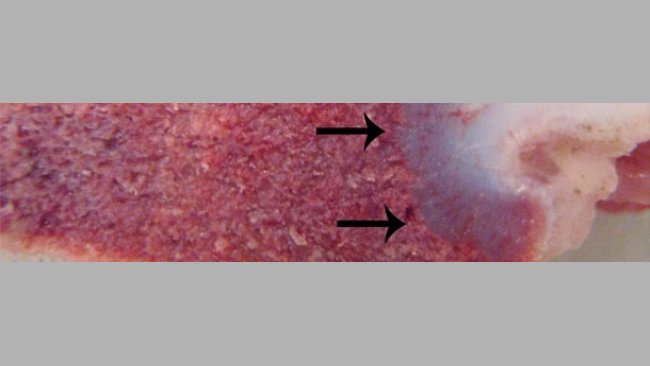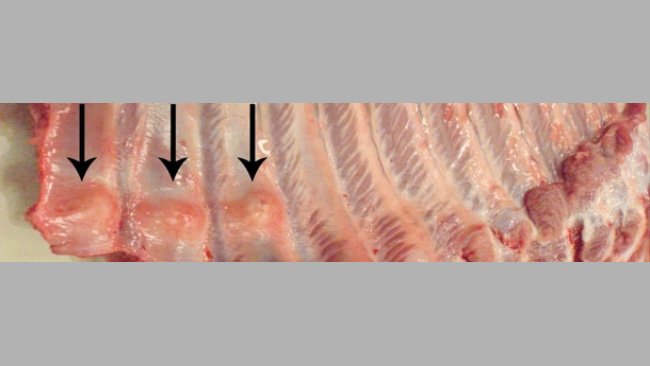
Vitamin D deficiency syndromes in swine (II)
We have long known that of all the species tested, piglets are born with the lowest circulating levels of 25(OH)D.
The pig sector events all around the world
Pig health: news and articles on PRRS, PCV2, biosecurity, etc, Pig disease guide, atlas of pathology, clinical cases…
Biocheck.UGent is an independent, risk-based, scientific scoring system for assessing the quality of your on-farm biosecurity.
A visual and practical step-by-step guide on how to perform a necropsy on a pig.
All the information about ASF: how to recognize the disease, how it is transmitted, pictures of lesions, latest news, guides, etc.
Description of the most important diseases and conditions in pigs
Images of major swine diseases
Pig disease diagnostic tool
Definition for the most commonly used pig terms
Simulator that calculates the amount of drug to add to the water when using a flow dispenser.
Pig Prices by countries. Pork production and trade. News of the pig market and the raw materials
The latest slaughter pig prices in the most important pig markets. Check the evolution of the historical prices in charts and in several currencies.
Latest quotations for the main commodities used in pig feed. Historical graphs with the pig price and estimated feed price.
Figures & trends in pig numbers, pork production and pork trade.
Global production and trade data for the most important raw materials
Articles on nutrition and pig feeding, characteristics of raw materials and additives for pig feed. Prices of raw materials
Latest quotations for the main commodities used in pig feed. Historical graphs with the pig price and estimated feed price.
Technical sheets of the main raw materials and additives used in swine feed. They include a comparison of nutritional values from various sources, product
Global production and trade data for the most important raw materials
Definition for the most commonly used pig terms
Use this tool to diagnose problems with the feed conversion ratio. Click on the flowchart or on the buttons within the text to navigate through the different parts of the tool.
Articles on genetics and pig reproduction: genetic improvement, genomics, artificial insemination, use of hormones
Compare production data, calculate the number of sow, nursery, and finishing spaces, and visualize your tasks on the work schedule by type of BMS.
Tool that allows you to calculate the replacement rate in your farm
Definition for the most commonly used pig terms
Use this tool to find out why your farrowing rate is less than ideal. Click on the flowchart or on the buttons found within the text to navigate through the different parts of the tool.
Management, pig farm management, work planning in each production stage: management in gestation, grow finish, batch farrowing
Compare production data, calculate the number of sow, nursery, and finishing spaces, and visualize your tasks on the work schedule by type of BMS.
Tool that allows you to calculate the replacement rate in your farm
Definition for the most commonly used pig terms
Design of facilities and equipment for pig farms: building design, climate control, feeding systems, etc.
Biocheck.UGent is an independent, risk-based, scientific scoring system for assessing the quality of your on-farm biosecurity.
Definition for the most commonly used pig terms
Use this tool to explore which slurry management strategy best fits your situation. Click on the flow chart or on the buttons within the text to navigate through the different parts of the tool.
What makes us stand out is the quality and independence of our contents. Find out about the authors who make it possible. Our goal is to generate a virtual community of advanced users in the sector.

Rank: Assistant Professor, Veterinary Diagnostic and Production Animal Medicine College of Veterinary Medicine, Iowa State University, Ames, IA 50011
Education:
| Institution | Degree | Date | Major |
| University of Minnesota | BS | May 2002 | Veterinary Sciences |
| University of Minnesota | DVM | May 2004 | Veterinary Medicine |
| Iowa State University | PhD | August 2009 | Veterinary Pathology |
Board Certification: Diplomate, American College of Veterinary Pathologists, Anatomic Pathology.
Record of professional experience:
| Year | Position |
| 2009 - present | Diagnostic Pathologist; Iowa State University College of Veterinary Medicine |
| 2006 - 2009 | Adjunct instructor; Iowa State University College of Veterinary Medicine |
| 2004 - 2006 | Production veterinarian; Christensen Family Farms, Sleepy Eye, Minnesota |
Updated CV 29-Jun-2013

We have long known that of all the species tested, piglets are born with the lowest circulating levels of 25(OH)D.

Vitamin D is normally produced following skin exposure to ultraviolet-B. Since most piglets (and humans too!) are raised in climate controlled housing and born year-round, direct access to sunshine is often limited, even in the summer. Fortunately, vitamin D can be added to diets to meet the animals' need for vitamin D.
Welcome to 333
Connect, share, and interact with the largest community of professionals in the swine industry.
Celebrating 138260Users on 333!
Sign upAlready a member?




